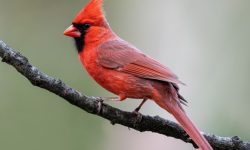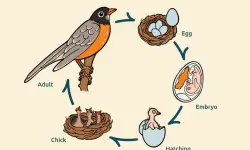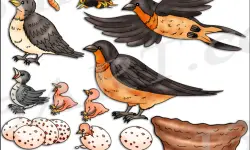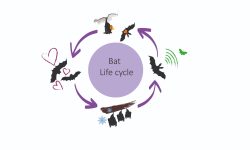Michigan’s rich array of lakeshores, wetlands, and open fields provides habitat for a diverse group of shorebirds known as plovers. These small to medium-sized birds, part of the Charadriidae family, are known for their short bills, rounded heads, and distinct foraging behavior. Among the many shorebird species observed in the state, seven types of plovers have been recorded, ranging from common breeders to rare accidental visitors. This article explores each species, offering identification tips, seasonal occurrence, and conservation issues.
American Golden-Plover (Pluvialis dominica)
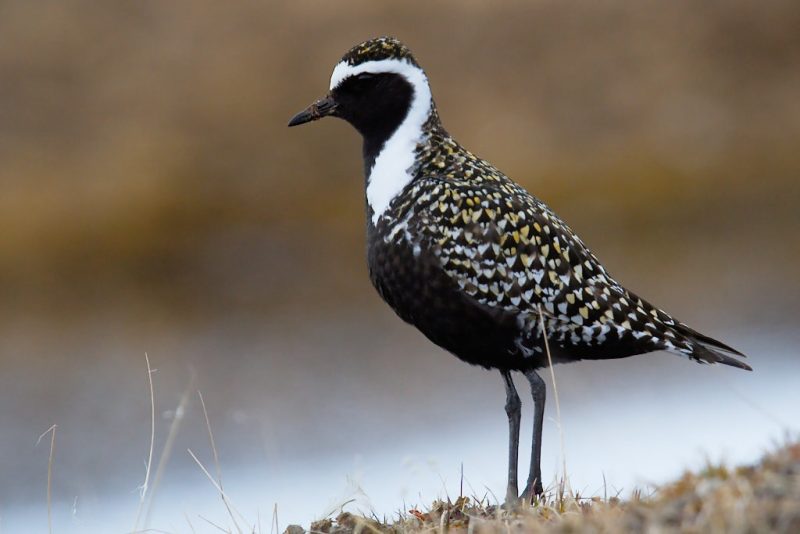
Identification and Physical Traits
The American Golden-Plover is a sleek, elegant shorebird, slightly smaller and slimmer than its cousin, the Black-Bellied Plover. It is especially known for its striking breeding plumage: a deep black face, throat, chest, and belly, sharply bordered by a brilliant white stripe that curves from the forehead down the sides of the neck and flanks. Its upperparts are mottled gold and black—offering superb camouflage amid the mosses and lichens of the Arctic tundra.
In nonbreeding plumage, which is often seen during migration in Michigan, the bird is much plainer—grayish-brown above with a pale face and underparts. The white supercilium (eyebrow) and slightly longer, more tapered wings help distinguish it from the similar but stockier Black-Bellied Plover.
Its long, pointed wings and fast, agile flight make it one of the more aerodynamic plovers, adapted to long-distance migration.
Seasonal Presence in Michigan
The American Golden-Plover is a long-distance migrant, traveling each year from its breeding grounds in the Arctic tundra of Alaska and northern Canada to wintering areas in southern South America, particularly Argentina and Uruguay.
Michigan serves as an important stopover site during both spring (late April to early June) and fall (August to October) migrations. In spring, individuals follow a central flyway through the interior U.S., while in fall, many take a more easterly, transoceanic route via the Atlantic. However, a portion of the fall population does pass through the Great Lakes region.
In Michigan, they can be found:
-
In open agricultural fields, especially those recently plowed or harvested
-
On mudflats and lake margins during low water levels
-
In short-grass prairies or airport fields that mimic their native tundra-like habitat
They typically forage in solitude or loose groups, sometimes associating with Killdeers or other shorebirds.
Conservation and Migration Concerns
The American Golden-Plover once suffered severe population declines in the late 1800s due to unregulated market hunting during migration, particularly in the eastern U.S. Though populations have recovered substantially, the species remains vulnerable to habitat disruption.
Key threats today include:
-
Loss of stopover habitat in North America due to agriculture, drainage, and development
-
Climate change impacting the timing of food availability on both breeding and wintering grounds
-
Disturbance from human activity in agricultural or open field habitats during critical resting periods
Because of its epic migration—one of the longest of any shorebird—preserving critical stopover sites in Michigan is essential to the species’ long-term survival. Efforts to maintain mudflats, wet prairies, and managed agricultural lands for resting and feeding benefit not only American Golden-Plovers but a suite of other migratory shorebirds as well.
As a symbol of endurance and global connectivity, the American Golden-Plover reminds us that even birds that only briefly pass through Michigan depend on the health of the state’s ecosystems.
Black-Bellied Plover (Pluvialis squatarola)
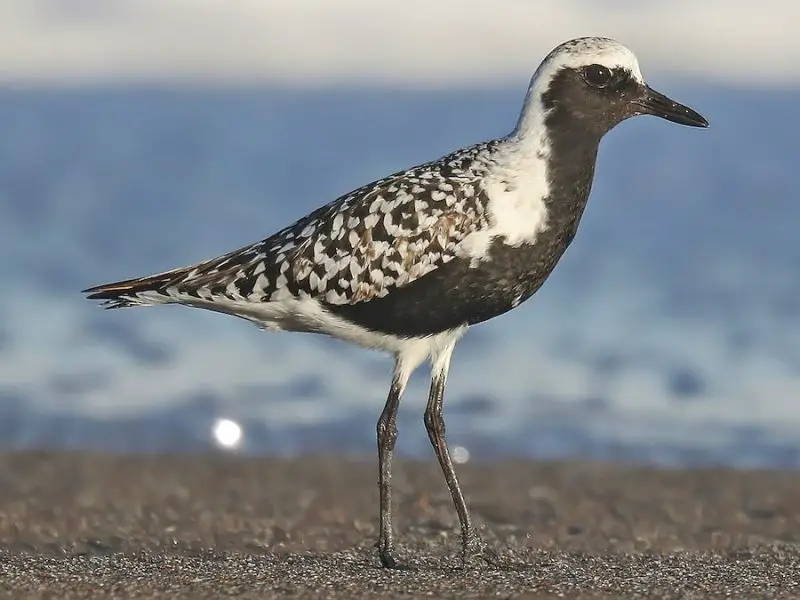
Identification and Seasonal Plumage
The Black-Bellied Plover is the largest plover species in the world, notable for its bold appearance and wide range. During the breeding season, adults are unmistakable: they display a striking black face, neck, and belly, sharply contrasted with silvery-gray upperparts and a bright white crown and rump. This bold, high-contrast plumage makes them stand out among Arctic-breeding shorebirds.
In nonbreeding (basic) plumage, which is most commonly seen in Michigan, the bird takes on a much duller look—with grayish upperparts, white underparts, and a faint mottled facial pattern. Immature birds resemble nonbreeding adults but may show more streaking on the breast and sides.
Its thick, straight black bill and relatively long legs, along with its stocky build, help distinguish it from smaller plovers.
Habitat and Occurrence in Michigan
While Black-Bellied Plovers do not nest in Michigan, they are regular and fairly common migrants along the state’s shorelines, beaches, and inland mudflats. Their main migration periods occur from late April through May and again in late August to October, when individuals stop to refuel during their long journey between Arctic breeding grounds and southern wintering areas, which include coastal South America, the Gulf of Mexico, and parts of Africa and Asia.
Preferred habitats in Michigan include:
-
Open, flat shorelines with sparse vegetation
-
Exposed mudflats along the Great Lakes
-
Sandbars, flooded fields, and occasionally inland wetlands
Because of their preference for open visibility, they are most easily observed with binoculars or scopes during coastal birding excursions.
Behavior and Notable Traits
Black-Bellied Plovers are cautious and alert by nature, often the first species in a mixed shorebird flock to take flight when disturbed. Their vigilance can serve as an early warning for more tolerant birds like sandpipers or dowitchers.
They emit a loud, clear “pee-o-wee” or “kleer-loo” call when flushed or in flight, which is highly diagnostic and aids birders in identifying them from a distance—even in poor light.
Unlike some smaller plovers, they do not forage in flocks, instead preferring to feed alone or in loose aggregations. Their foraging style is deliberate: short runs punctuated by pauses, searching for insects, marine worms, and small crustaceans.
Conservation and Global Significance
Though not currently considered threatened, the Black-Bellied Plover depends on a network of healthy coastal wetlands and mudflats across its migratory route. Any loss or degradation of stopover sites—such as through shoreline development, pollution, or climate-induced flooding—can impact the species’ ability to complete its long migrations successfully.
Its wide distribution and striking appearance make it a favorite among birders and an important species for monitoring the health of global coastal ecosystems.
Killdeer (Charadrius vociferus)
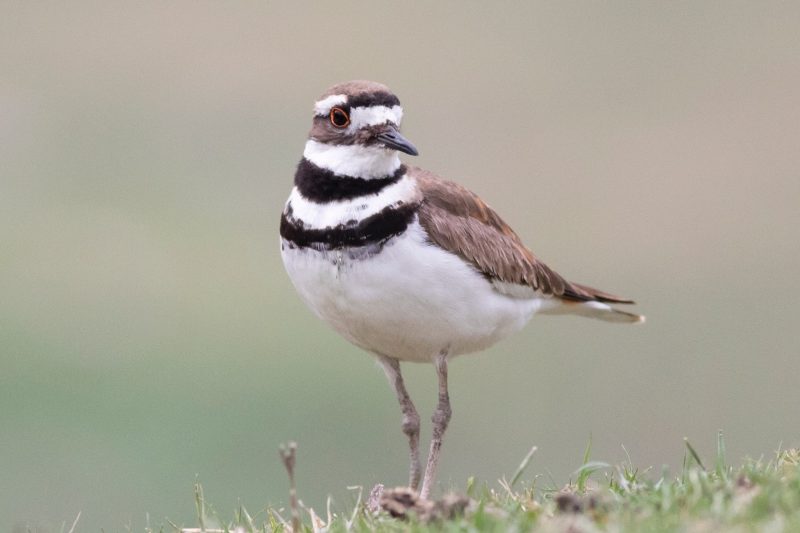
Distinctive Traits and Vocalizations
The Killdeer is the most widespread and easily recognized plover in North America, known as much for its call as for its appearance. It has a slim build, long legs, and a rounded head. Its plumage includes warm brown upperparts, a bright white underside, and two bold black breast bands—a key field mark that sets it apart from similar species like the Semipalmated Plover. Its bright red eye ring becomes more visible during the breeding season.
The bird’s name comes from its unmistakable, high-pitched call—“kill-dee” or “kill-deer”—which it gives in flight or when disturbed. The call is often one of the first sounds to signal spring’s arrival in many parts of the Midwest.
Resident Status and Distribution in Michigan
Killdeers are common and widespread breeders throughout Michigan, occupying a broad range of habitats. Unlike most plovers that prefer shorelines and mudflats, Killdeers thrive in human-altered landscapes, such as:
-
Farmlands and pasture
-
Golf courses
-
Schoolyards and sports fields
-
Parking lots and gravel rooftops
-
Open lawns and airfields
They typically arrive in early spring (March) and remain through late fall (October). Some individuals may even overwinter in southern Michigan during milder seasons, thanks to their adaptability and access to open ground.
Nesting Behavior and Adaptation
One of the most remarkable aspects of Killdeer behavior is its ability to nest in unlikely places. Nests are simple scrapes made on gravel or bare soil, often right next to roads, in construction zones, or even on flat rooftops. Despite this vulnerability, Killdeers have evolved effective defensive behaviors to protect their nests and young.
The most famous of these is the “broken wing act”—a dramatic display in which the adult feigns injury by dragging a wing and calling frantically, luring predators away from the nest. Once the intruder is at a safe distance, the adult quickly flies off unharmed.
Killdeers also exhibit site fidelity, returning to the same nesting territories year after year, and often reusing successful nest sites.
Role in Human-Dominated Landscapes
Because they often nest and forage in areas frequented by people, Killdeers are one of the few shorebirds whose behavior and life cycle are regularly observed by the general public. They serve as a living example of wildlife resilience in urban and agricultural environments. However, their proximity to human activity also exposes them to risks such as collisions with vehicles, pesticide exposure, and nest disturbance from foot traffic or machinery.
Although still common, continued awareness and habitat mindfulness—even in developed areas—can help ensure that Killdeer populations remain robust across Michigan.
Piping Plover (Charadrius melodus)
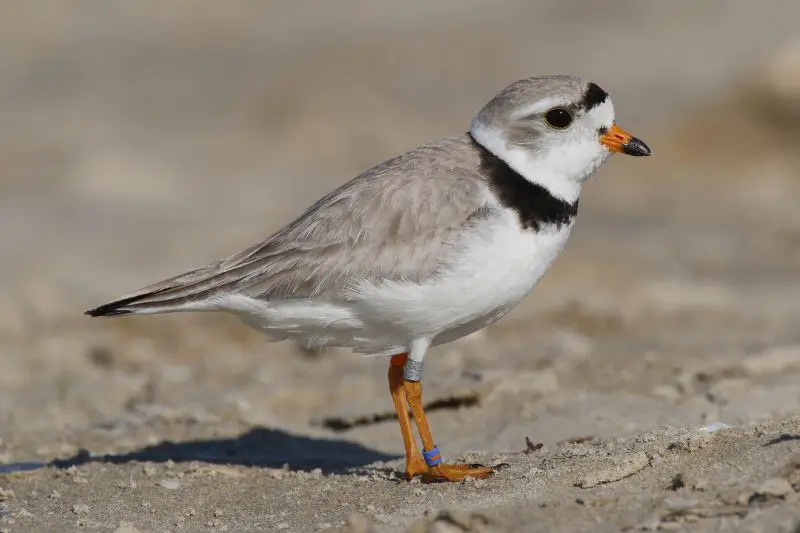
Identification and Endangered Status
The Piping Plover is a small, sand-colored shorebird that blends seamlessly with its beach environment. It has pale gray upperparts, white underparts, orange legs, and a short orange bill with a black tip. A distinctive black band runs across the forehead, and a single black collar encircles the neck—often thinner or incomplete in some individuals. During the breeding season, its soft, bell-like whistles—“peep-lo”—can be heard from a distance, giving the species its name.
It is one of the most conservation-sensitive birds in North America and serves as an important indicator of coastal ecosystem health.
Michigan’s Conservation Symbol
The Piping Plover has a longstanding presence in Michigan, particularly along the northern Lake Michigan shoreline and parts of Lake Huron. Breeding sites include Sleeping Bear Dunes National Lakeshore, Platte River Point, Tawas Point, and other stretches of remote beach where human traffic is limited.
The Great Lakes population of the Piping Plover is federally listed as endangered, with fewer than 100 breeding pairs remaining in this region as of recent counts. Michigan plays a crucial role in the species’ survival, as it hosts the majority of nesting pairs in the entire Great Lakes region.
Threats and Recovery Efforts
Piping Plovers face numerous threats, most notably habitat loss, human disturbance, and predation. As these birds nest directly on open sand, their eggs and chicks are easily trampled by beachgoers, destroyed by off-road vehicles, or preyed upon by gulls, raccoons, and unleashed dogs.
To combat these pressures, intensive conservation efforts are underway. Key strategies include:
-
Fencing and signage around nesting areas to prevent accidental disturbance.
-
Volunteer monitoring programs, which document nesting activity and educate beach visitors.
-
Predator management to increase chick survival.
-
Captive rearing and release programs when eggs are abandoned or at risk.
Thanks to decades of coordinated conservation work, the population is slowly increasing, though it remains highly vulnerable. The Piping Plover has become a symbol of beach conservation in Michigan, representing a broader call to balance human recreation with ecological protection.
Semipalmated Plover (Charadrius semipalmatus)
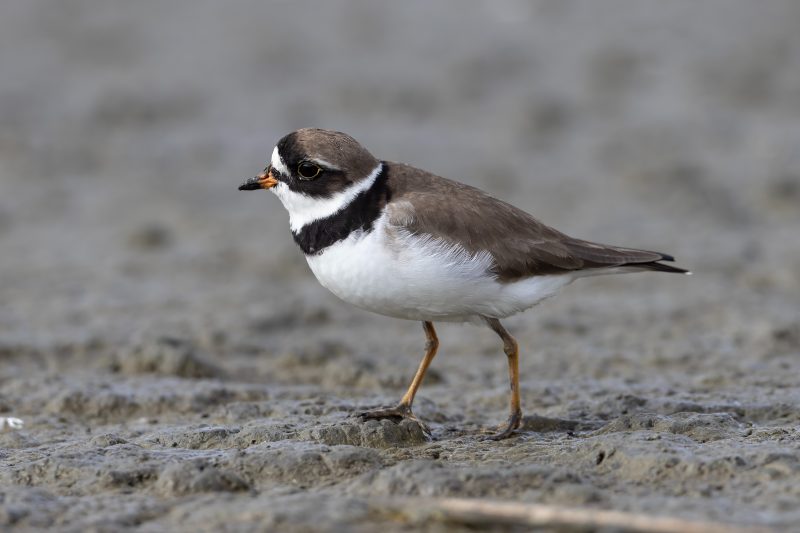
Description and Foraging Habits
The Semipalmated Plover is a compact, elegant shorebird, easily recognized by its crisp black neck ring, white forehead, and warm brown upperparts. Its short, stubby bill is orange with a black tip, and it walks on bright orange legs. Though often confused with the Killdeer, it is much smaller and has only one dark breast band instead of two. The term “semipalmated” refers to the partial webbing between its toes—an adaptation that helps it maneuver in muddy, wet environments.
It forages with a characteristic run-and-pause gait, scanning the ground for small invertebrates like insects, marine worms, and crustaceans. It often feeds along tidal flats, sandy shores, and the muddy edges of inland lakes.
Migration Through Michigan
In Michigan, the Semipalmated Plover is a common and widespread migrant, observed during both spring (April to May) and fall (August to October) migration seasons. It does not breed in the state but uses Michigan’s extensive wetland systems and Great Lakes shorelines as important stopover sites while traveling between its Arctic breeding grounds and tropical wintering areas in Central and South America.
These stopovers are critical for refueling during migration, as the species undertakes long-distance flights across North America.
Ecological Role and Population Trends
As a specialized insectivore, the Semipalmated Plover plays a valuable ecological role in maintaining healthy insect populations in coastal and wetland ecosystems. It consumes a wide range of benthic invertebrates, contributing to the natural balance of shoreline food webs.
Fortunately, this species is currently considered globally secure, with population trends appearing stable. However, it remains vulnerable to threats that affect wetland health, such as pollution, habitat drainage, and shoreline development. Because it relies on a network of safe and productive stopover sites during migration, conservation of these habitats in Michigan and beyond is essential for sustaining long-term populations.
Snowy Plover (Charadrius nivosus) — Accidental
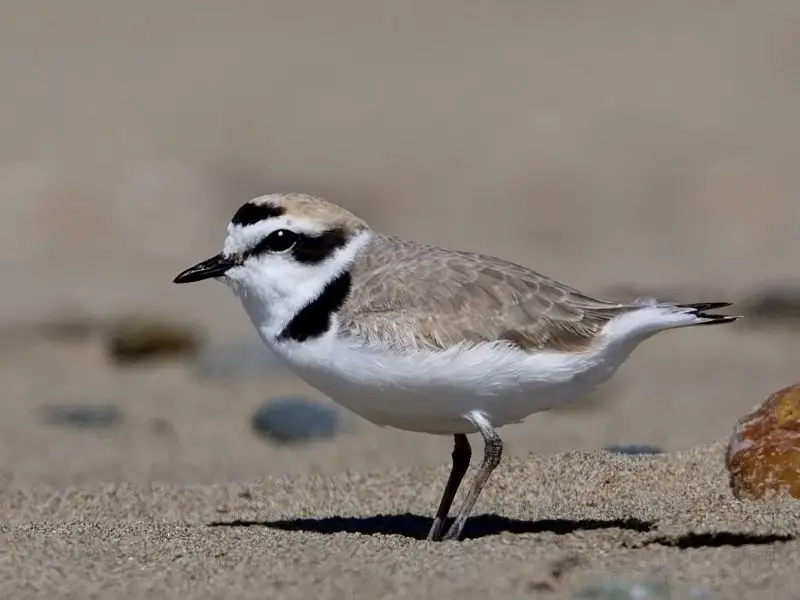
Rare and Delicate Appearance
The Snowy Plover is a small, pale shorebird with a graceful, almost ethereal presence. It has sandy gray upperparts that blend seamlessly with dry, open habitats like beaches and salt flats, and white underparts that enhance its ghostlike look. Its bill is short, straight, and black, while its legs range from dark gray to black. Unlike many other plovers, the Snowy Plover often lacks prominent breastbands—showing only faint dark patches on the sides of the neck, particularly in females and nonbreeding individuals.
This minimalist appearance, combined with its small size and subtle plumage, makes the Snowy Plover especially difficult to spot, even in open habitats. It forages by running and pausing, feeding on insects and small invertebrates close to the ground.
Status and Occurrence in Michigan
Snowy Plovers are accidental visitors in Michigan, with only a handful of confirmed records. Their core range lies far to the west and south of the Great Lakes, primarily along the Pacific Coast, Gulf of Mexico, and inland saline lakes across the southwestern United States. Breeding populations are concentrated in areas like California, Utah, and coastal Texas, where they nest on flat, sparsely vegetated ground.
Sightings in Michigan are extremely rare and are usually tied to unusual weather events or disoriented migration patterns. These vagrant individuals do not stay long and typically do not return in following seasons.
Conservation Concerns and Broader Implications
The Snowy Plover is a species of conservation concern, especially along the Pacific Coast, where the subspecies nivosus is federally listed as Threatened in the U.S. Major threats include beach habitat loss, disturbance from human recreation, predation, and rising sea levels. Nests, often laid in shallow scrapes in the sand, are especially vulnerable to trampling and vehicle activity.
While its presence in Michigan is not biologically significant in terms of local breeding populations, it highlights broader issues in bird migration—such as habitat fragmentation, storm displacement, and potential climate-driven changes to migratory routes. For birders, spotting a Snowy Plover in the state is a rare and exciting event; for conservationists, it’s a reminder of how fragile these specialized birds can be in a rapidly changing world.
Wilson’s Plover (Charadrius wilsonia) — Accidental
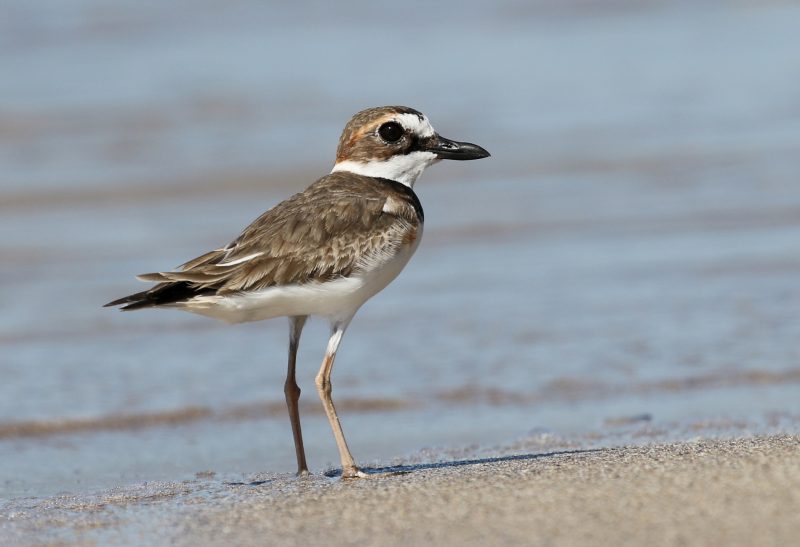
Identification and Features
Wilson’s Plover is a stocky shorebird known for its large, thick black bill—distinctly larger than other small plovers. It has gray-brown upperparts, a white underside, and a single broad dark breastband. Its pale pinkish legs and relatively plain plumage make it subtly elegant. Males show darker markings in breeding season, while the soft “pwip” call helps distinguish it by sound.
Habitat and Range
This species prefers sandy beaches, tidal flats, and salt pans along the southeastern U.S. coast, from North Carolina to Texas. It is largely coastal and rarely ventures inland. It breeds on open, sparsely vegetated shorelines and is a year-round resident in parts of Florida and the Gulf Coast.
Occurrence in Michigan
Wilson’s Plover is a very rare visitor to Michigan, with only a few recorded sightings. These accidental appearances are likely the result of strong weather events or navigational errors during migration. Its presence in the state is highly unusual and of particular interest to birdwatchers.
Conservation Notes
Although not globally endangered, Wilson’s Plover faces regional threats due to habitat loss and human disturbance, particularly on nesting beaches. Its scattered populations and specific habitat needs make it vulnerable. The bird’s rare occurrence in Michigan highlights broader ecological issues like climate change and the importance of protecting both coastal and inland migratory stopovers.
Conclusion
Plovers are an integral part of Michigan’s avian biodiversity. From common residents like the Killdeer to rare wanderers such as the Snowy and Wilson’s Plovers, each species contributes to the state’s rich birdlife. Monitoring their presence provides insight into environmental health, habitat quality, and broader migration patterns across North America. Continued conservation of shoreline habitats and public awareness are key to ensuring that Michigan remains a haven for these remarkable shorebirds—whether they’re here to breed, pass through, or just visiting by accident.

